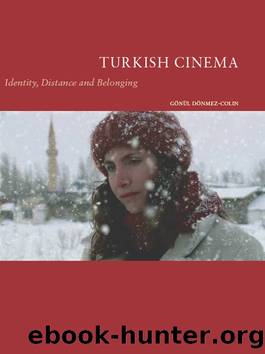Andrei Tarkovsky by Robert Bird

Author:Robert Bird
Language: eng
Format: epub
Publisher: Reaktion Books
5 Gender, Sexuality and Morals
in Transition
The provincial girl: Who said Iâll marry you?
Her boyfriend: But we slept together.
The provincial girl: Just because I slept with you once,
do I have to sleep with you for the rest of my life?1
Women have been the focus of Turkish cinema since its beginnings, although their visibility has not always been beneficial to their identity. Cinema arrived in Turkey as an entertainment for men by men and remained so for many years. At the beginning of the twentieth century armed fundamentalists were occupying theatres threatening to knife any woman who dared to enter. Women had to wait even longer to become actors. All female roles were played by non-Muslims until the foundation of the secular Turkish Republic in 1923.
As early as 1917 the âfallen womanâ motif was established with Pençe / The Clutch, by Sedat Simavi, which featured two âpromiscuousâ women, one with an insatiable appetite for men and the other an adulteress. This was followed by Ahmet Fehimâs sex vaudeville Mürebbiye / The Governess (1919), presenting Angélique, an amoral French beauty, who seduced all the men in a rich household. Filmmakers habitually exploited the female body through the medium of comedy, the camera objectifying the female and turning her into a spectacle, confirming Laura Mulveyâs contention that the spectatorial look in mainstream cinema is implicitly male; the image represents the ideological meaning that âwomanâ has for men: the male as active and powerful and the female as passive and powerless as a subject, on which power is exercised, either as a victim or as an object that needs to be protected, and the spectator identifies with the male look.2
YeÅilçam portrayed love as the first condition of marriage in a period when marriages were still arranged; love involved individual choice and paved the path for the emancipation of women. Ironically, for the majority of society love was not considered as necessary for marriage and in fact was a threat to morals. Although films showed love that ended in marriage as a victory for the woman, the same love would limit the womanâs freedom and reinforce the manâs dominance. The woman who fought familial and societal pressures to marry the man she loved was expected to adhere to the patriarchal laws of society or she would pay for her misdemeanour.3
âWomenâs filmsâ dominated the industry in the 1950s and â60s when the female audience was a gold mine for the producers. The star system born in the 1960s typecast four top stars according to audience expectations: Türkan Åoray, the oppressed sexual woman; Hülya KoçyiÄit, the oppressed asexual woman; Filiz Akın, the well-educated asexual bourgeois woman; and Fatma Girik (who became the mayor of an uptown municipality in the 1990s), the honest âmanlyâ asexual woman, known as erkek fatma (male Fatma, which did not mean masculine, but rather honest and straightforward like a man). According to Atıf Yılmaz, these stars represented masks similar to those worn in traditional Eastern arts, such as the Kabuki theatre of Japan. When communications advanced with television, the Internet, etc.
Download
This site does not store any files on its server. We only index and link to content provided by other sites. Please contact the content providers to delete copyright contents if any and email us, we'll remove relevant links or contents immediately.
Still Foolin’ ’Em by Billy Crystal(36234)
Spell It Out by David Crystal(36014)
The Great Music City by Andrea Baker(31229)
Professional Troublemaker by Luvvie Ajayi Jones(29563)
Trainspotting by Irvine Welsh(21471)
Call Me by Your Name by André Aciman(20340)
We're Going to Need More Wine by Gabrielle Union(18927)
The Secret History by Donna Tartt(18788)
Cat's cradle by Kurt Vonnegut(15127)
Ready Player One by Cline Ernest(14473)
Molly's Game by Molly Bloom(14041)
Bombshells: Glamour Girls of a Lifetime by Sullivan Steve(13942)
The Goal (Off-Campus #4) by Elle Kennedy(13410)
Leonardo da Vinci by Walter Isaacson(13131)
4 3 2 1: A Novel by Paul Auster(12245)
The Social Justice Warrior Handbook by Lisa De Pasquale(12101)
The Break by Marian Keyes(9282)
Crazy Rich Asians by Kevin Kwan(9143)
Adultolescence by Gabbie Hanna(8809)
